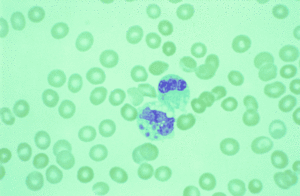Ehrlichia: tick-borne pathogen in canines and humans: Difference between revisions
| Line 21: | Line 21: | ||
==Section 1== | ==Section 1== | ||
<br>Include some current research in each topic, with at least one figure showing data.<br> | <br>Include some current research in each topic, with at least one figure showing data.<br> | ||
[[Image:EMILY2.jpg|thumb|300px|right|This image from the CDC illustrates the transmission cycles responsible for the maintenance of E. chaffeensis and E. canis, allowing for the infection of Dogs and humans.]] | [[Image:EMILY2.jpg|thumb|300px|right|This image from the CDC illustrates the transmission cycles responsible for the maintenance of E. chaffeensis and E. canis, allowing for the infection of Dogs and humans. http://www.sciencedirect.com/science/article/pii/S1471492210000188]] | ||
==Section 2== | ==Section 2== | ||
Revision as of 22:36, 22 April 2013
Introduction

At right is a sample image insertion. It works for any image uploaded anywhere to MicrobeWiki. The insertion code consists of:
Double brackets: [[
Filename: PHIL_1181_lores.jpg
Thumbnail status: |thumb|
Pixel size: |300px|
Placement on page: |right|
Legend/credit: Electron micrograph of the Ebola Zaire virus. This was the first photo ever taken of the virus, on 10/13/1976. By Dr. F.A. Murphy, now at U.C. Davis, then at the CDC.
Closed double brackets: ]]
Other examples:
Bold
Italic
Subscript: H2O
Superscript: Fe3+
Section 1
Include some current research in each topic, with at least one figure showing data.

Section 2
Include some current research in each topic, with at least one figure showing data.
Section 3
Include some current research in each topic, with at least one figure showing data.
Conclusion
Overall paper length should be 3,000 words, with at least 3 figures.
References
Edited by student of Joan Slonczewski for BIOL 238 Microbiology, 2009, Kenyon College.
